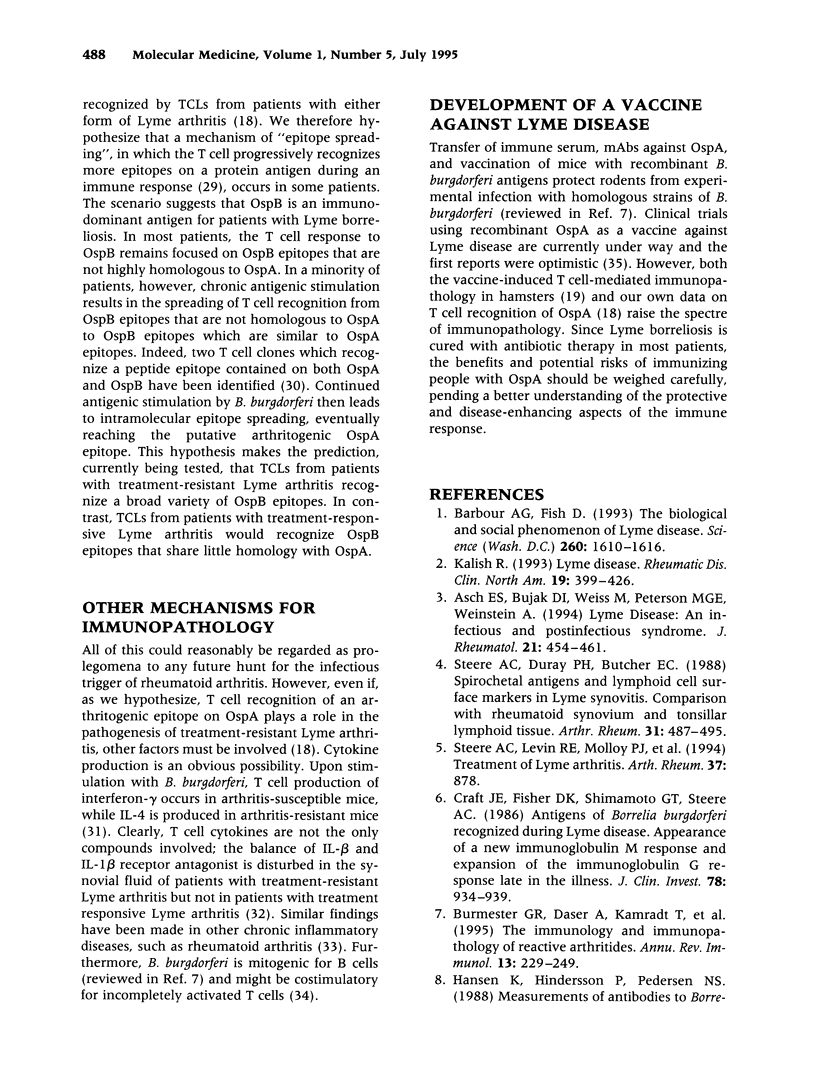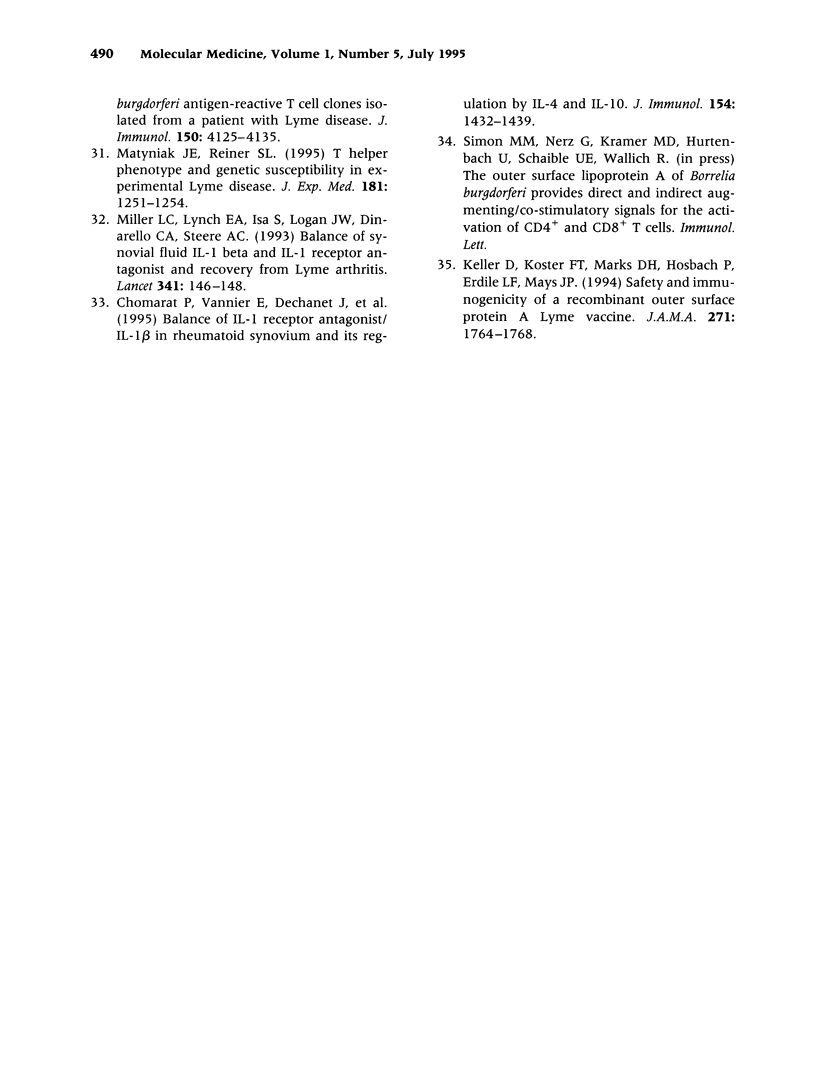Full text
PDF




Selected References
These references are in PubMed. This may not be the complete list of references from this article.
- Asch E. S., Bujak D. I., Weiss M., Peterson M. G., Weinstein A. Lyme disease: an infectious and postinfectious syndrome. J Rheumatol. 1994 Mar;21(3):454–461. [PubMed] [Google Scholar]
- Barbour A. G., Fish D. The biological and social phenomenon of Lyme disease. Science. 1993 Jun 11;260(5114):1610–1616. doi: 10.1126/science.8503006. [DOI] [PubMed] [Google Scholar]
- Bradley J. F., Johnson R. C., Goodman J. L. The persistence of spirochetal nucleic acids in active Lyme arthritis. Ann Intern Med. 1994 Mar 15;120(6):487–489. doi: 10.7326/0003-4819-120-6-199403150-00007. [DOI] [PubMed] [Google Scholar]
- Brocke S., Gaur A., Piercy C., Gautam A., Gijbels K., Fathman C. G., Steinman L. Induction of relapsing paralysis in experimental autoimmune encephalomyelitis by bacterial superantigen. Nature. 1993 Oct 14;365(6447):642–644. doi: 10.1038/365642a0. [DOI] [PubMed] [Google Scholar]
- Burmester G. R., Daser A., Kamradt T., Krause A., Mitchison N. A., Sieper J., Wolf N. Immunology of reactive arthritides. Annu Rev Immunol. 1995;13:229–250. doi: 10.1146/annurev.iy.13.040195.001305. [DOI] [PubMed] [Google Scholar]
- Chomarat P., Vannier E., Dechanet J., Rissoan M. C., Banchereau J., Dinarello C. A., Miossec P. Balance of IL-1 receptor antagonist/IL-1 beta in rheumatoid synovium and its regulation by IL-4 and IL-10. J Immunol. 1995 Feb 1;154(3):1432–1439. [PubMed] [Google Scholar]
- Craft J. E., Fischer D. K., Shimamoto G. T., Steere A. C. Antigens of Borrelia burgdorferi recognized during Lyme disease. Appearance of a new immunoglobulin M response and expansion of the immunoglobulin G response late in the illness. J Clin Invest. 1986 Oct;78(4):934–939. doi: 10.1172/JCI112683. [DOI] [PMC free article] [PubMed] [Google Scholar]
- Gahring L. C., Weigle W. O. The regulatory effects of cytokines on the induction of a peripheral immunologic tolerance in mice. J Immunol. 1990 Sep 1;145(5):1318–1323. [PubMed] [Google Scholar]
- Goverman J., Woods A., Larson L., Weiner L. P., Hood L., Zaller D. M. Transgenic mice that express a myelin basic protein-specific T cell receptor develop spontaneous autoimmunity. Cell. 1993 Feb 26;72(4):551–560. doi: 10.1016/0092-8674(93)90074-z. [DOI] [PubMed] [Google Scholar]
- Habicht G. S., Beck G., Benach J. L., Coleman J. L., Leichtling K. D. Lyme disease spirochetes induce human and murine interleukin 1 production. J Immunol. 1985 May;134(5):3147–3154. [PubMed] [Google Scholar]
- Häupl T., Hahn G., Rittig M., Krause A., Schoerner C., Schönherr U., Kalden J. R., Burmester G. R. Persistence of Borrelia burgdorferi in ligamentous tissue from a patient with chronic Lyme borreliosis. Arthritis Rheum. 1993 Nov;36(11):1621–1626. doi: 10.1002/art.1780361118. [DOI] [PubMed] [Google Scholar]
- Kalish R. Lyme disease. Rheum Dis Clin North Am. 1993 May;19(2):399–426. [PubMed] [Google Scholar]
- Kamradt T., Soloway P. D., Perkins D. L., Gefter M. L. Pertussis toxin prevents the induction of peripheral T cell anergy and enhances the T cell response to an encephalitogenic peptide of myelin basic protein. J Immunol. 1991 Nov 15;147(10):3296–3302. [PubMed] [Google Scholar]
- Keane-Myers A., Nickell S. P. T cell subset-dependent modulation of immunity to Borrelia burgdorferi in mice. J Immunol. 1995 Feb 15;154(4):1770–1776. [PubMed] [Google Scholar]
- Keller D., Koster F. T., Marks D. H., Hosbach P., Erdile L. F., Mays J. P. Safety and immunogenicity of a recombinant outer surface protein A Lyme vaccine. JAMA. 1994 Jun 8;271(22):1764–1768. [PubMed] [Google Scholar]
- Lehmann P. V., Forsthuber T., Miller A., Sercarz E. E. Spreading of T-cell autoimmunity to cryptic determinants of an autoantigen. Nature. 1992 Jul 9;358(6382):155–157. doi: 10.1038/358155a0. [DOI] [PubMed] [Google Scholar]
- Lengl-Janssen B., Strauss A. F., Steere A. C., Kamradt T. The T helper cell response in Lyme arthritis: differential recognition of Borrelia burgdorferi outer surface protein A in patients with treatment-resistant or treatment-responsive Lyme arthritis. J Exp Med. 1994 Dec 1;180(6):2069–2078. doi: 10.1084/jem.180.6.2069. [DOI] [PMC free article] [PubMed] [Google Scholar]
- Lim L. C., England D. M., DuChateau B. K., Glowacki N. J., Schell R. F. Borrelia burgdorferi-specific T lymphocytes induce severe destructive Lyme arthritis. Infect Immun. 1995 Apr;63(4):1400–1408. doi: 10.1128/iai.63.4.1400-1408.1995. [DOI] [PMC free article] [PubMed] [Google Scholar]
- Matyniak J. E., Reiner S. L. T helper phenotype and genetic susceptibility in experimental Lyme disease. J Exp Med. 1995 Mar 1;181(3):1251–1254. doi: 10.1084/jem.181.3.1251. [DOI] [PMC free article] [PubMed] [Google Scholar]
- Miller L. C., Lynch E. A., Isa S., Logan J. W., Dinarello C. A., Steere A. C. Balance of synovial fluid IL-1 beta and IL-1 receptor antagonist and recovery from Lyme arthritis. Lancet. 1993 Jan 16;341(8838):146–148. doi: 10.1016/0140-6736(93)90006-3. [DOI] [PubMed] [Google Scholar]
- Nocton J. J., Dressler F., Rutledge B. J., Rys P. N., Persing D. H., Steere A. C. Detection of Borrelia burgdorferi DNA by polymerase chain reaction in synovial fluid from patients with Lyme arthritis. N Engl J Med. 1994 Jan 27;330(4):229–234. doi: 10.1056/NEJM199401273300401. [DOI] [PubMed] [Google Scholar]
- Ohashi P. S., Oehen S., Buerki K., Pircher H., Ohashi C. T., Odermatt B., Malissen B., Zinkernagel R. M., Hengartner H. Ablation of "tolerance" and induction of diabetes by virus infection in viral antigen transgenic mice. Cell. 1991 Apr 19;65(2):305–317. doi: 10.1016/0092-8674(91)90164-t. [DOI] [PubMed] [Google Scholar]
- Oldstone M. B. Molecular mimicry as a mechanism for the cause and a probe uncovering etiologic agent(s) of autoimmune disease. Curr Top Microbiol Immunol. 1989;145:127–135. doi: 10.1007/978-3-642-74594-2_11. [DOI] [PubMed] [Google Scholar]
- Radolf J. D., Norgard M. V., Brandt M. E., Isaacs R. D., Thompson P. A., Beutler B. Lipoproteins of Borrelia burgdorferi and Treponema pallidum activate cachectin/tumor necrosis factor synthesis. Analysis using a CAT reporter construct. J Immunol. 1991 Sep 15;147(6):1968–1974. [PubMed] [Google Scholar]
- Schaible U. E., Kramer M. D., Wallich R., Tran T., Simon M. M. Experimental Borrelia burgdorferi infection in inbred mouse strains: antibody response and association of H-2 genes with resistance and susceptibility to development of arthritis. Eur J Immunol. 1991 Oct;21(10):2397–2405. doi: 10.1002/eji.1830211016. [DOI] [PubMed] [Google Scholar]
- Schaible U. E., Wallich R., Kramer M. D., Nerz G., Stehle T., Museteanu C., Simon M. M. Protection against Borrelia burgdorferi infection in SCID mice is conferred by presensitized spleen cells and partially by B but not T cells alone. Int Immunol. 1994 May;6(5):671–681. doi: 10.1093/intimm/6.5.671. [DOI] [PubMed] [Google Scholar]
- Steere A. C., Duray P. H., Butcher E. C. Spirochetal antigens and lymphoid cell surface markers in Lyme synovitis. Comparison with rheumatoid synovium and tonsillar lymphoid tissue. Arthritis Rheum. 1988 Apr;31(4):487–495. doi: 10.1002/art.1780310405. [DOI] [PubMed] [Google Scholar]
- Steere A. C., Dwyer E., Winchester R. Association of chronic Lyme arthritis with HLA-DR4 and HLA-DR2 alleles. N Engl J Med. 1990 Jul 26;323(4):219–223. doi: 10.1056/NEJM199007263230402. [DOI] [PubMed] [Google Scholar]
- Steere A. C., Levin R. E., Molloy P. J., Kalish R. A., Abraham J. H., 3rd, Liu N. Y., Schmid C. H. Treatment of Lyme arthritis. Arthritis Rheum. 1994 Jun;37(6):878–888. doi: 10.1002/art.1780370616. [DOI] [PubMed] [Google Scholar]
- Wucherpfennig K. W., Strominger J. L. Molecular mimicry in T cell-mediated autoimmunity: viral peptides activate human T cell clones specific for myelin basic protein. Cell. 1995 Mar 10;80(5):695–705. doi: 10.1016/0092-8674(95)90348-8. [DOI] [PMC free article] [PubMed] [Google Scholar]
- Yang L., Ma Y., Schoenfeld R., Griffiths M., Eichwald E., Araneo B., Weis J. J. Evidence for B-lymphocyte mitogen activity in Borrelia burgdorferi-infected mice. Infect Immun. 1992 Aug;60(8):3033–3041. doi: 10.1128/iai.60.8.3033-3041.1992. [DOI] [PMC free article] [PubMed] [Google Scholar]
- Yang L., Weis J. H., Eichwald E., Kolbert C. P., Persing D. H., Weis J. J. Heritable susceptibility to severe Borrelia burgdorferi-induced arthritis is dominant and is associated with persistence of large numbers of spirochetes in tissues. Infect Immun. 1994 Feb;62(2):492–500. doi: 10.1128/iai.62.2.492-500.1994. [DOI] [PMC free article] [PubMed] [Google Scholar]


